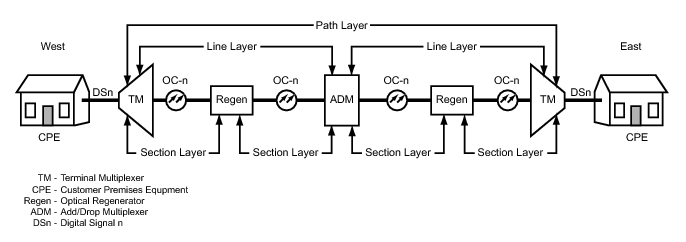SONET (Synchronous Optical Network) is a fiber-optic transmission system standard for high-speed digital telecommunications. Its specifications define optical carrier (OC) interfaces and their electrical equivalents, Synchronous Transport Signal (STS) for the fiber-optic transmission as shown in Table: “SONET Hierarchy”. SONET is based on transmissions speeds in multiples of 51.84 Mb/s.
|
Synchronous Transport Signal (STS)
|
||
The STS-1 frame is composed of octets that are nine rows high and 90 columns wide. The first three columns are used by the Transport Overhead (TOH), which contains framing, error monitoring, management, and payload pointer information. The data (Payload) uses the remaining 87 columns, of which the first column is used for Path Overhead (POH). A pointer in the TOH identifies the start of the payload that is referred to as the Synchronous Payload Envelope (SPE).
OC-3c is an extension of the basic STS-1 speed by a multiple of three and operates at 155.520 Mb/s. Concatenating three STS-1 frames results in a OC-3c frame with nine rows and 270 columns. In OC-3c, the STS-1 frames are not independent, but have become one frame with a much larger payload.
SONET provides substantial overhead information allowing simpler multiplexing and greatly expanded Operations, Administration, Maintenance, and Provisioning (OAM&P) capabilities. The overhead information has several layers, which are shown in Figure: “SONET Overhead Information”. Path-level overhead is carried from end-to-end. Line overhead is for the OC-n signal between OC-n multiplexers. Section overhead is used for communications between adjacent network elements, such as regenerators.
Enough information is contained in the overhead to allow the network to operate and allow OAM&P communications between an intelligent network controller and the individual nodes. The following sections detail the different SONET overhead information:
Section Overhead contains 10 bytes of the transport overhead accessed, generated, and processed by section-terminating equipment. This overhead supports functions such as:
|
•
|
This may be two regenerators, line terminating equipment, and a regenerator, or two line terminating equipment. The Section Overhead is found in the first three rows of Columns 1 through 9 illustrated in Figure: “OC-3c Frame Structure”.
Line Overhead contains 17 bytes of overhead accessed, generated, and processed by line terminating equipment. This overhead supports functions such as:
The Line Overhead is found in Rows 4 to 9 of Columns 1 through 9 illustrated in Figure: “OC-3c Frame Structure”.
Path Overhead (OC POH) contains four evenly distributed Path Overhead bytes per 125 microseconds starting at the first byte of the OC SPE. OC POH provides for communication between the point of creation of an OC SPE and its point of disassembly. This overhead supports functions such as:
The Path Overhead is found in Rows 1 to 9 of the first column of the OC SPE illustrated in Figure: “OC-3c Frame Structure”.
BIP calculations are performed over each layer of the SONET overhead such that each bit in the BIP byte will indicate the parity of all respective bits in the previous frame. For example, if the number of bits equaling one in the first bit position of every byte is odd, then the first bit position of the BIP byte will be one. This is repeated for all eight bits of each byte to determine the value of the BIP byte.
Each layer calculates the BIP for all information in its domain. For example, since the entire SONET signal is formed when the STE sees it, the Section BIP is calculated over the entire signal, including all SOH, LOH, and POH of the previous frame. The result is then placed in the B1 byte of the next frame. Line BIP’s are calculated over the previous frame, excluding the SOH, and placed in the B2 bytes of the next frame. Path BIP’s are calculated over the previous frame, minus SOH and LOH, and placed in the B3 byte of the next frame.





